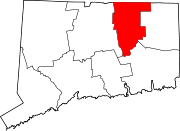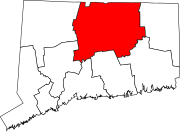|
Ellington, Connecticut
Ellington is a town in Tolland County, Connecticut, United States. Ellington was incorporated in May 1786, from East Windsor. The town is part of the Capitol Planning Region. As of the 2020 census, the town population was 16,426.[2] HistoryOriginally the area in what is now Ellington was named by the natives as “Weexskashuck” which translates to “Great Marsh”. The earliest settlers called the area Great Marsh or Goshen. In 1671, the town of Windsor, purchased the land of East Windsor and Ellington from the Native Americans to recover land loss from the Connecticut-Massachusetts border dispute. Though no one attempted to settle the fertile lands for another 50 years. Samuel Pinney was the first settler in today's Ellington (Pinney Road bears his name in town). In 1733, Ellington was established as a Parish of the town of Windsor. East Windsor then split off from Windsor and held land in what is today's East Windsor, South Windsor and Ellington in May 1768. Ellington split off twenty years later and incorporated itself in May 1786. Mostly known as an agricultural community, the Crystal Lake section of town was for a while a popular summer resort location.[3] Ellington still has a significant amount of property dedicated to agriculture including cattle and corn farming. Ellington's sole representative to the voting on the adoption of the United States Constitution by Connecticut was Ebenezer Nash. Nash was an anti-federalist and voted against the ratification, which passed 128–40.[4] Ellington is home to one of America's oldest roadside memorials, remembering a boy killed in a road accident. A stone in the southwest corner of the town marks the site where Samuel Knight was killed "by a cartwheel rolling over his head in the 10th year of his age, Nov 8, 1812". The Christian hymn, "I love to steal awhile away" was written by Phoebe Hinsdale Brown in Ellington based on a personal experience in August 1818. During the late 19th century and early 20th century, Ellington became the center of a community of Jewish immigrant farmers who were settled there by the philanthropist Baron Maurice de Hirsch's Jewish Colonization Association. They built a synagogue, Congregation Knesseth Israel,[5] that is still standing and in use by an active Modern Orthodox congregation today and is on the National Register of Historic Places.[6]  On January 1, 1967, Ellington made national news when its residents assisted the city fire department in rescuing a pilot whose plane was having engine trouble and was unable to locate a runway in a fog that cut visibility to 200 feet. Under the direction and quick thinking of Resident State Trooper, Lionel Labreche, Connecticut State Police, dozens of people assembled at the town's unlit airstrip, Hyde Field, and illuminated the runway with their headlights, allowing the pilot to land safely.[7] In 1991, Ellington was proposed as a potential site for a low-level nuclear waste dump. Strong dissent from area residents forced the state to abandon the plan.[8] As it enters the 21st century, Ellington has had the 6th fastest growth rate of all the towns in Connecticut,[9] and has been experiencing changes in growing from a rural farming town into a suburban community. Exemplative of this change was the displacement of the locally owned Ellington Supermarket by competition from the regional Big Y supermarket chain when a new Big Y was built adjacent to the older supermarket.[10] An independent film entitled The Supermarket, was made about the incident.[11][12] GeographyAccording to the United States Census Bureau, the town has a total area of 34.6 square miles (90 km2), of which 34.0 square miles (88 km2) is land and 0.6 square miles (1.6 km2) (1.59%) is water. Ellington is bordered by the towns of East Windsor, South Windsor, Vernon, Tolland, Willington, Stafford, Somers, and Enfield. The town has a panhandle extending to the east that extends to the Willimantic River and encompasses Crystal Lake. A large portion of the town's eastern portion is occupied by the Shenipsit State Forest which is bounded on the south by Shenipsit Lake and on the north by Soapstone Mountain.[13] Neighborhoods
Demographics
As of the census[15] of 2000, there were 12,921 people, 5,195 households, and 3,470 families residing in the town. Ellington's population increased 20.8% between 2000 and 2010, making one of just four municipalities in Connecticut to achieve a growth rate of at least 20% for that period.[16] The population density was 379.4 inhabitants per square mile (146.5/km2). There were 5,417 housing units at an average density of 159.1 per square mile (61.4/km2). The racial makeup of the town was 96.23% White, 0.99% African American, 0.16% Native American, 1.29% Asian, 0.01% Pacific Islander, 0.44% from other races, and 0.87% from two or more races. Hispanic or Latino of any race were 1.40% of the population. There were 5,195 households, out of which 32.5% had children under the age of 18 living with them, 57.4% were married couples living together, 6.6% had a female householder with no husband present, and 33.2% were non-families. 26.8% of all households were made up of individuals, and 6.4% had someone living alone who was 65 years of age or older. The average household size was 2.48 and the average family size was 3.06. In the town, the population was spread out, with 25.2% under the age of 18, 6.5% from 18 to 24, 35.0% from 25 to 44, 23.6% from 45 to 64, and 9.7% who were 65 years of age or older. The median age was 37 years. For every 100 females, there were 98.9 males. For every 100 females age 18 and over, there were 96.3 males. The median income for a household in the town was $62,405, and the median income for a family was $77,813. Males had a median income of $47,334 versus $32,460 for females. The per capita income for the town was $27,766. About 2.7% of families and 3.6% of the population were below the poverty line, including 4.1% of those under age 18 and 3.9% of those age 65 or over.
EconomyEllington is a rapidly growing community, and is going through the process of suburbanization,[9][20] which is related to the phenomenon of urban sprawl. Top employers in Ellington according to the town's 2023 Comprehensive Annual Financial Report[21]
EducationEllington Public Schools belong to the Ellington Public Schools school district.[22][23] The district has five public schools: Elementary schools
Middle school
High schoolInfrastructureRoadsThough no Interstate Highways pass through Ellington it is approximately equidistant from both Interstate 84 and Interstate 91, each being approximately a ten- to fifteen-minute drive from most parts of town. Several Connecticut State Roads run through town:
RailEllington was formerly served by a seven-mile-long rail line built in 1876 running from Vernon to Melrose, that roughly paralleled Pinney St. and Sadds Mill Rd. The rail line became defunct in the middle part of the 20th century.[24] The New England Central Railroad (following the Willimantic River) also briefly clips through the very eastern edge of Ellington, though has no stops.  Airports
WaterCrystal Lake, in the eastern section of town, is used by many for boating. Notable people
See alsoReferences
External linksWikimedia Commons has media related to Ellington, Connecticut. Wikivoyage has a travel guide for Ellington.
There are three different public elementary schools in Ellington,ct the schools are, center school, windermere, and crystal lake. There is also one public middle school, and a public high school. |
|||||||||||||||||||||||||||||||||||||||||||||||||||||||||||||||||||||||||||||||||||||||||||||||||||||||||||||||||||||||||||||||||||||||||||||||||||||||||||||||||||||||||||||||||||||||||||||||||||||||||||||||||||||||||||||||||||||||||||||||||||||||||||||||||||||||||||||||||||||||||||||||||||||||||||||









